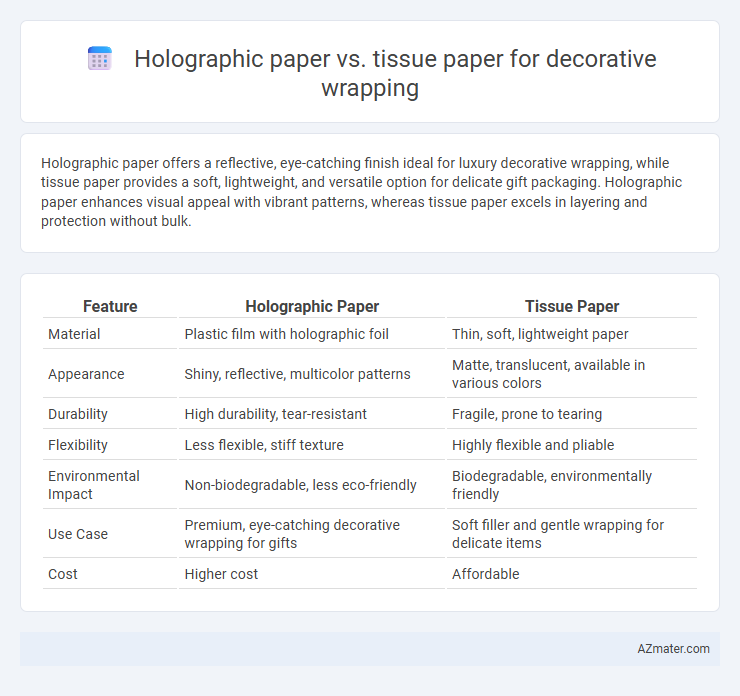Holographic paper offers a reflective, eye-catching finish ideal for luxury decorative wrapping, while tissue paper provides a soft, lightweight, and versatile option for delicate gift packaging. Holographic paper enhances visual appeal with vibrant patterns, whereas tissue paper excels in layering and protection without bulk.
Table of Comparison
| Feature | Holographic Paper | Tissue Paper |
|---|---|---|
| Material | Plastic film with holographic foil | Thin, soft, lightweight paper |
| Appearance | Shiny, reflective, multicolor patterns | Matte, translucent, available in various colors |
| Durability | High durability, tear-resistant | Fragile, prone to tearing |
| Flexibility | Less flexible, stiff texture | Highly flexible and pliable |
| Environmental Impact | Non-biodegradable, less eco-friendly | Biodegradable, environmentally friendly |
| Use Case | Premium, eye-catching decorative wrapping for gifts | Soft filler and gentle wrapping for delicate items |
| Cost | Higher cost | Affordable |
Introduction: Overview of Decorative Wrapping Materials
Holographic paper offers a vibrant, reflective surface that enhances gift presentation with dynamic light effects, making it ideal for festive occasions and luxury packaging. Tissue paper provides a soft, lightweight option that adds delicate texture and color layering, perfect for cushioning and elegantly wrapping fragile items. Both materials serve distinct purposes in decorative wrapping, balancing visual appeal and functional protection based on the desired presentation style.
What is Holographic Paper?
Holographic paper features a dynamic, multi-dimensional surface created using laser technology that reflects light to produce vibrant, rainbow-like visuals, making it ideal for decorative wrapping that demands a striking, eye-catching appearance. Unlike tissue paper, which is thin and translucent, holographic paper is thicker and more durable, providing enhanced protection and a premium look for gift presentation. Its unique optical effects and sturdy texture make holographic paper a superior choice for adding a luxurious, festive touch to wrapped items.
What is Tissue Paper?
Tissue paper is a lightweight, translucent material made from thin fibers, commonly used for decorative wrapping due to its softness and flexibility. It provides a delicate, matte finish that enhances the presentation of gifts with subtle elegance, absorbing dyes well for vibrant colors. Unlike holographic paper, tissue paper is biodegradable and cost-effective, making it a popular eco-friendly choice for wrapping fragile items.
Visual Appeal: Shine vs. Subtlety
Holographic paper offers a captivating shine with its reflective and rainbow-like surface, making it ideal for eye-catching decorative wrapping that stands out in any setting. Tissue paper provides a subtle elegance through its matte finish and soft texture, adding a delicate, understated charm to wrapped gifts. Choosing between holographic and tissue paper depends on whether the desired visual appeal leans towards vibrant brilliance or gentle sophistication.
Texture and Tactile Experience
Holographic paper offers a smooth, glossy texture with a reflective, eye-catching surface that enhances the visual appeal of decorative wrapping. In contrast, tissue paper has a soft, lightweight, and slightly crinkled texture that provides a gentle tactile experience and easy manipulation for delicate wrapping. The choice between holographic and tissue paper depends on the desired tactile sensation and overall aesthetic impact of the wrapped item.
Durability and Protection
Holographic paper offers superior durability with its laminated, tear-resistant surface, making it ideal for protecting delicate or heavy items during wrapping. Tissue paper is softer and more flexible, providing gentle cushioning but less resistance to tearing or moisture exposure. For decorative wrapping that requires enhanced protection and longevity, holographic paper is the preferred choice over tissue paper.
Versatility in Decorative Uses
Holographic paper offers eye-catching reflective patterns ideal for vibrant gift wrapping, party decorations, and festive crafts, providing a striking visual impact. Tissue paper excels in versatility by adding softness, volume, and color contrast to wrapping, stuffing, and layering in decorative displays. Combining both materials enhances dimensionality and aesthetic appeal, catering to diverse creative wrapping needs.
Environmental Impact and Sustainability
Holographic paper often contains plastic coatings and metallic elements that hinder recyclability and contribute to environmental pollution, making it less sustainable compared to tissue paper. Tissue paper is typically biodegradable, compostable, and sourced from renewable materials, resulting in a lower ecological footprint. Choosing tissue paper for decorative wrapping aligns better with efforts to reduce waste and promote environmental responsibility.
Cost Comparison
Holographic paper typically costs 20-30% more than tissue paper due to its metallic finish and complex manufacturing process. Tissue paper remains a budget-friendly option, priced lower per sheet and often available in bulk, making it ideal for large-scale decorative wrapping. For cost-conscious consumers, tissue paper offers greater affordability, while holographic paper is a premium choice for eye-catching presentation.
Choosing the Right Wrapping Paper for Your Needs
Holographic paper delivers a vibrant, eye-catching shine ideal for festive or luxury gift wrapping, while tissue paper offers lightweight, delicate protection perfect for layering and cushioning fragile items. Selecting the right wrapping paper depends on the desired aesthetic and the nature of the gift; holographic paper suits bold, decorative presentations, whereas tissue paper provides subtle elegance and softness. Consider the wrapping paper's thickness, durability, and visual effect to match your packaging goals precisely.

Infographic: Holographic paper vs Tissue paper for Decorative wrapping
 azmater.com
azmater.com